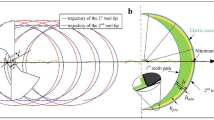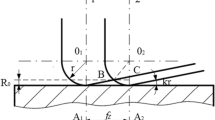Abstract
Micro end-milling is widely used in many industries to produce micro products with complex 3D shapes. The accurate modeling and prediction of surface roughness are important for evaluating the productivity of the machine tools and the surface quality of the machined parts. This paper presents an accurate surface roughness model based on the kinematics of cutting process and tool geometry by considering the effects of tool run-out and minimum chip thickness. The proposed surface roughness model is validated by micro end-milling experiments with the miniaturized machine tool. The results show that the proposed surface roughness model can accurately predict both the trends and magnitude of the surface roughness in micro end-milling.
Similar content being viewed by others
References
Jing XB, Li HZ, Wang J, Liow JL (2012) Experimental study of cutting forces in micro end-milling. Adv Mater Res 500(500):357–362
Wang W, Kweon S, Yang S (2005) A study on roughness of the micro-end-milled surface produced by a miniatured machine tool. J Mater Process Technol 162:702–708
Afazov S, Ratchev S, Segal J (2010) Modelling and simulation of micro-milling cutting forces. J Mater Process Technol 210(15):2154–2162
Miao J, Chen G, Lai X, Li H, Li C (2007) Review of dynamic issues in micro-end-milling. Int J Adv Manuf Technol 31(9):897–904
Thepsonthi T, Özel T (2012) Multi-objective process optimization for micro-end milling of Ti-6Al-4V titanium alloy. Int J Adv Manuf Technol 63(9–12):903–914
Munoz De Escalona P, Maropoulos PG (2015) A geometrical model for surface roughness prediction when face milling Al 7075-T7351 with square insert tools. J Manuf Syst 36:216–223
Wang M-Y, Chang H-Y (2004) Experimental study of surface roughness in slot end milling AL2014-T6. Int J Mach Tools Manuf 44(1):51–57
Cardoso P, Davim JP (2010) Optimization of surface roughness in micromilling. Mater Manuf Process 25(10):1115–1119
Wang J, Gong Y, Shi J, Abbay G (2009) Surface roughness prediction in micromilling using neural networks and Taguchi’s design of experiments. Industrial Technology, ICIT 2009, IEEE International Conference, pp 1–6
Kuram E, Ozcelik B (2013) Multi-objective optimization using Taguchi based grey relational analysis for micro-milling of Al 7075 material with ball nose end mill. Measurement 46(6):1849–1864
DeVor RE, Kapoor SG (2004) On the modeling and analysis of machining performance in micro-endmilling, part I: surface generation. J Manuf Sci Eng 126(4):685–694
Li H, Lai X, Li C, Feng J, Ni J (2007) Modelling and experimental analysis of the effects of tool wear, minimum chip thickness and micro tool geometry on the surface roughness in micro-end-milling. J Micromech Microeng 18(2):025006
Lee K, Dornfeld DA (2004) A study of surface roughness in the micro-end-milling process. Consortium on deburring and edge finishing. Laboratory for manufacturing and sustainability, Berkeley
Jin X, Altintas Y (2012) Prediction of micro-milling forces with finite element method. J Mater Process Technol 212(3):542–552
Wang J-J, Zheng C (2003) Identification of cutter offset in end milling without a prior knowledge of cutting coefficients. Int J Mach Tools Manuf 43(7):687–697
Li K, Zhu K, Mei T (2016) A generic instantaneous undeformed chip thickness model for the cutting force modeling in micromilling. Int J Mach Tools Manuf 105:23–31
Lee K, Kim H, Park S (2007) A run-out measuring method using modeling and simulation in four-fluted end milling. J Mater Process Technol 187:207–211
Jing XB, Li HZ, Wang J, Tian YL (2014) Modelling the cutting forces in micro-end-milling using a hybrid approach. Int J Adv Manuf Technol 73(9–12):1647–1656
Funding
The authors would like to thank for support by the National Foundation of China (Grant No. 51675371).
Author information
Authors and Affiliations
Corresponding author
Rights and permissions
About this article
Cite this article
Yuan, Y., Jing, X., Ehmann, K.F. et al. Surface roughness modeling in micro end-milling. Int J Adv Manuf Technol 95, 1655–1664 (2018). https://doi.org/10.1007/s00170-017-1278-x
Received:
Accepted:
Published:
Issue Date:
DOI: https://doi.org/10.1007/s00170-017-1278-x




